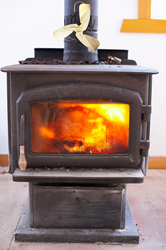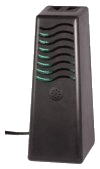15 Cities Added to EPA’s “Sooty Air List”: Is Yours on the List?
by www.SixWise.com
Elected officials in 211 counties in 25 states were notified by the Environmental Protection Agency (EPA) that their air violated daily standards for fine particles of pollution.

One in three Americans is breathing sooty air, according to the EPA. |
The standards were tightened in 2006 from 65 micrograms per cubic meter of air to 35 micrograms per cubic meter. If the levels of fine particles -- emitted by power plants, livestock operations, diesel engines, and wood-burning stoves -- in an area exceed 35 micrograms per cubic meter for more than 24 hours, the area is considered not in compliance, or a “"nonattainment area.”
Nonattainment areas, which now impact more than 100 million people living in 46 metro areas, are required to create plans on how to clean up their air by 2012, and carry out those plans by 2014.
What is Fine Particle Pollution?
Particulate matter (PM) is a term used to describe particles in the air, such as dust, dirt, soot, smoke and liquid droplets. Those that are less than 10 micrometers in diameter can be inhaled and accumulate in your respiratory system, leading to health problems. However, those that are less than 2.5 micrometers in diameter (PM2.5), which are called “fine particles,” pose the greatest health risk.
According to the EPA, because of their small size (approximately 1/30th the average width of a human hair) fine particles can lodge deeply into your lungs.
Studies have linked air pollution to increased risk of heart attacks and strokes, and it’s known to make respiratory problems worse by increasing inflammation.
In all, about 4 percent of deaths in the United States can be attributed to air pollution, according to the Environmental Science Engineering Program at the Harvard School of Public Health.
Further, about one out of every three people in the United States is at a higher risk of experiencing health effects due to fine particle pollution, the EPA points out.
“One group at high risk is active children because they often spend a lot of time playing outdoors and their bodies are still developing. In addition, oftentimes the elderly population is at risk. People of all ages who are active outdoors are at increased risk because, during physical activity, PM2.5 penetrates deeper into the parts of the lungs that are more vulnerable to injury,” the EPA writes on their Web site.
Which Areas Have Violated EPA Standards?
Fifteen cities were added to the sooty air list, from states ranging from Alaska, Utah and Idaho to Wisconsin. Meanwhile, 54 counties that didn’t violate soot standards in 2004 were marked as nonattainment areas in 2008. They include areas such as Davenport and Muscatine, Iowa, Seattle, Washington, Green Bay, Madison and Milwaukee, Wisconsin and the Logan, Utah area.
You can visit the EPA’s site to see the entire list of nonattainment counties.
Clean air advocates have also pointed out that some areas with unclear air may not have made the list, because the EPA actually has two sets of soot standards -- daily and long-term yearly.

Widespread use of wood-burning stoves may be partly to blame for the poor air quality in states such as Alaska, Utah and Wisconsin. |
While the daily standard was tightened in 2006, the yearly standard was not. And the EPA’s updated list only includes areas that have violated the daily standards; cities that violate the longer-term standards will not be reviewed, nor required to clean up their air.
According to Frank O'Donnell, president of the environmental group Clean Air Watch, there are at least five regions, including Houston, which have violated the yearly soot standards.
"EPA has failed to protect many millions of people from deadly particle soot by pretending that areas are clean where the air is actually dirty," O'Donnell said in an AP article. "The poster child for this is Houston."
How to Minimize Your Risks From Air Pollution
-
Purify your indoor air. The PIONAIR Air Treatment System, which Sixwise.com highly recommends, uses photocatalysis, which is designed to oxidize organic odors, germs, and fungi. The PIONAIR technology creates ultraviolet light rays, safe levels of ozone, and passive negative ions as part of your air treatment. This is not just any old air filter -- it is an air purifier that duplicates Nature's own methods of air cleaning and revitalization.
-
Keep dirt and dust out of your home. A few high-quality mats, like the Waterhog Grand Premier Mats, placed strategically around your home (such as in doorways and other highly trafficked areas), will go a long way toward reducing the amount of dirt and dust in your home in the first place. Once inside, that dirt gets circulated into the air and you breathe it in.
Purify Your Air, Fast, With PIONAIR
 With the PIONAIR Air Treatment System you can remove smoke, dust pet dander, mold, bacteria, pollen and more from your home and office air so you can breathe freely. With the PIONAIR Air Treatment System you can remove smoke, dust pet dander, mold, bacteria, pollen and more from your home and office air so you can breathe freely.
All PIONAIR Systems include a 30-Day Money-Back Guarantee!
And for a LIMITED TIME ONLY, Get $30 Off Each PIONAIR Air Treatment Unit, Plus FREE SHIPPING and a FREE MiniMate Refrigerator Unit!
Learn More About PIONAIR and ORDER NOW! |
-
Exercise when the air is cleaner. When you exercise (or work strenuously), you draw air more deeply into your lungs, and therefore risk more damage from air pollution. To protect yourself and get the numerous health benefits of exercise, avoid exercising near congested streets and during rush-hour traffic, and definitely if there's a wildfire burning in your area.
-
Clean your home properly. Removing excess dust and dirt is important to your air quality. However, if you use ordinary rags or mops, you will simply push dirt from one area to another -- NOT pick it up and eliminate it like you intended. That's why we recommend PerfectClean mops, cloths and dusters to give your home a microscopic level of clean. Every item is built with PerfectClean's revolutionary ultramicrofiber construction that enables them to reach deep into microscopic crevices (NO other cleaning tool available even comes close!) and remove everything in their path: all forms of dirt, dust, hair, dander, and the biological contaminants too small to see with the naked eye.
Recommended Reading
Surprising Facts About Air Pollution and How to Protect Yourself
What Exactly is in Every Breath You Take? Pieces of Bugs, Stars and Much More
Sources
The Christian Science Monitor December 23, 2008
Yahoo News December 22, 2008
U.S. EPA: Area Designations for 2006 24-Hour Fine Particle Standards